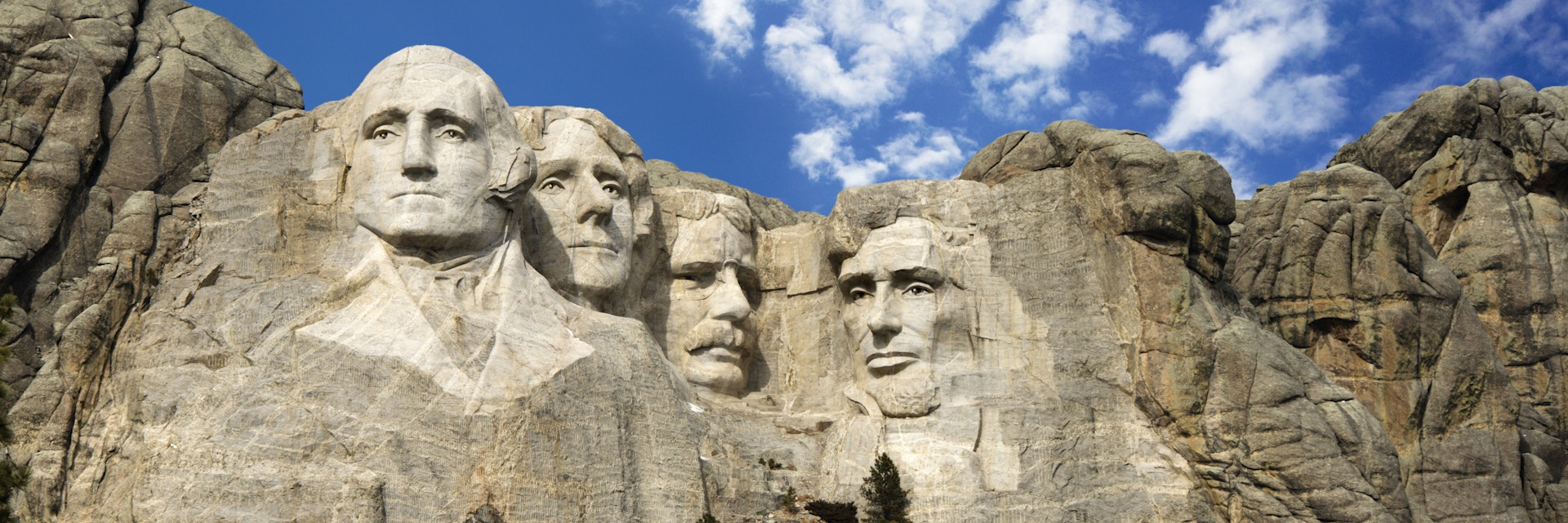Visitors can't help but be impressed by the sheer scale and massive physical effort of the team behind Mount Rushmore National Memorial in South Dakota. Looking like they're either emerging from or being absorbed by the mountain, the stony faces of past presidents George Washington, Thomas Jefferson, Abraham Lincoln and Theodore Roosevelt – carved 60ft tall in the granite of a Black Hills outcrop – are one of the most famous images in the US.
The monument attracts three million visitors each year, making it the top attraction in the state. The Avenue of Flags greets visitors on arrival, and it has 56 flags displayed on pillars that represent the 50 states, one district, three territories and two commonwealths of the US. Those who are able for climbing can take the half-mile Presidential Trail to see the stately bunch up close.
History of Mount Rushmore
Before it was named Mount Rushmore, the granite formation was known as Tunkasila Sakpe Paha, or Six Grandfathers Mountain, by the Lakota Sioux tribe, the original occupants of the area. The US government took ownership after the Great Sioux War of 1876, and it was later named Mount Rushmore after wealthy investor Charles E. Rushmore who visited the area regularly on prospecting and hunting trips.
South Dakota historian Doane Robinson is credited with conceiving the idea of carving the presidential figures into the granite of Mount Rushmore mountain in 1923 as a way to draw tourists to the state of South Dakota. The project received congressional approval in 1925, and the National Park Service took Mount Rushmore under its jurisdiction in 1933.
The carving started in 1927 and ended in 1941, with dynamite being used to blast the larger sections of rock. Sculptor Gutzon Borglum led the team of several hundred workers behind the project, while the chief carver of the mountain was Luigi del Bianco. George Washington's face was completed and dedicated in 1934, Thomas Jefferson’s in 1936, Abraham Lincoln’s in 1937 and Theodore Roosevelt’s in 1939. The entire project cost US$989,992.
Since then, the site has been updated with an austere series of granite pillars holding the flags of each of the 56 US territories and states. At night, the faces of Washington, Jefferson, Roosevelt and Lincoln are illuminated in a light show.
What to do at Mount Rushmore
The best way to see the monument is to arrive in the early morning, just before sunrise, when crowds are virtually absent, and the views are aided by the warm sunlight peaking over the horizon.
The Avenue of Flags leads to Grand View Terrace, the primary platform for viewing the monument. This is the best place to take photos and there are free telescopes there to get a close-up of the famous figures. If you can tackle 422 stairs, take a walk on the pine-shaded, half-mile Presidential Trail to get a little closer to the the stony fellows, and perhaps glimpse some of the local wildlife.
The Lincoln Borglum Visitor Center is located beneath the Grand View Terrace, and it has exhibits and a 14-minute film about the carving in Mount Rushmore. Visit the Sculptor's Studio and listen to a ranger talk about Gutzon Borglum, the carving process and the lives of the workers.
If you have small people with you, booklets are available at the information desks for the Junior Ranger program. If you fancy a bite to eat, dine in the Carvers' Café, and try the vanilla ice cream based on Thomas Jefferson’s original recipe from the the stand just outside the dining area.
Getting there and other practicalities
Mount Rushmore National Memorial is located on South Dakota Highway 44, 35 miles from Rapid City Regional Airport. No public transportation options are available.
Visitors traveling by car on I-90 should exit at Rapid City and follow US Highway 16 southwest to Keystone and then South Dakota Highway 244 to Mount Rushmore. Visitors coming from the south should follow US Highway 385 north to South Dakota Highway 244.
No reservations are needed to visit the memorial and it is free to visit. Parking is readily available in the memorial's parking complex, and costs $10 per vehicle and $5 for seniors aged 62 and older.
The busiest months are June, July and August. May, September and October are less busy but are popular months to visit as well. Consider visiting before 9am or after 3.30pm to avoid the crowds.
Acessibility
Brochures in Braille are available at the Information Center or Lincoln Borglum Visitor Center and an also be downloaded in advance. American Sign Language interpretation is available by request, free of charge. Requests must be received 14 days prior to your visit.
Vehicles can unload mobility-impaired visitors in front of the main entryway and then park in the parking lot. Manual wheelchairs are available to check out inside the Lincoln Borglum Visitor Center and are free to use. Elevators are accessible from the Grand View Terrace to the museum lobby and Amphitheater.
Depending on security issues, the Sculptor's Studio is wheelchair accessible from the remote parking area. Check with the ranger in the Lincoln Borglum Visitor Center. The Presidential Trail is surfaced to accommodate wheelchairs from the Grand View Terrace to viewing areas at the base of the mountain. Carvers' Café and the gift shop are wheelchair accessible.






